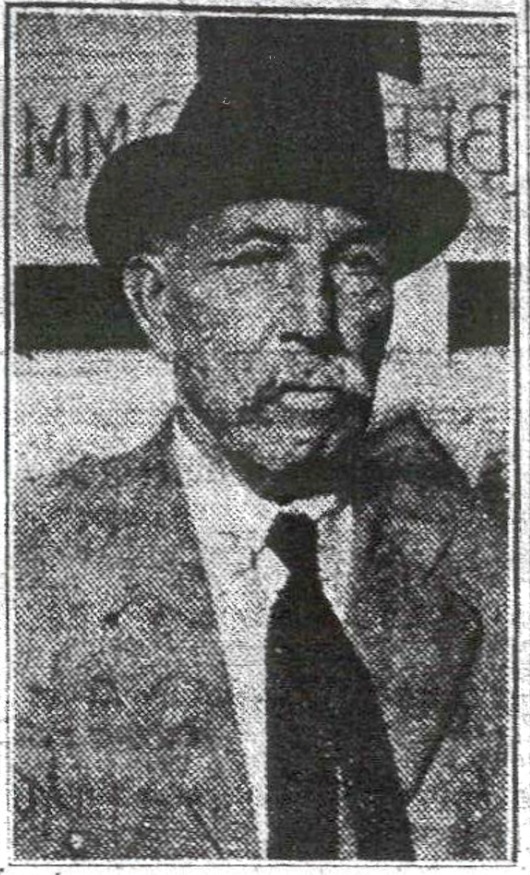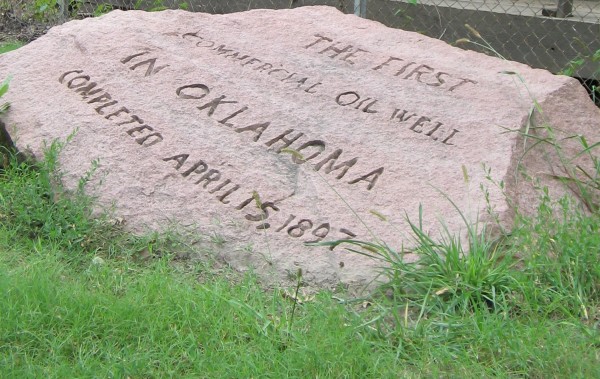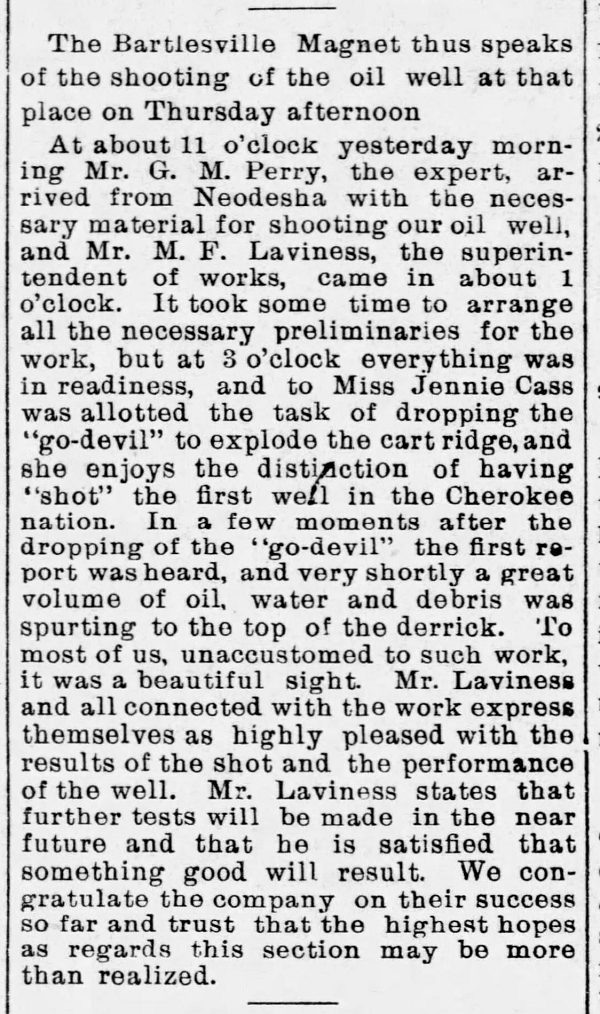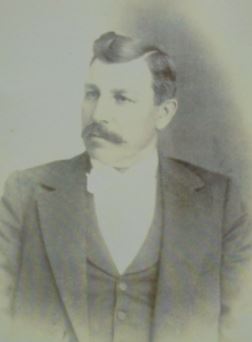Researching the life of Mareau LaViness, who worked in early Oklahoma oilfields.
While researching their history, the LaViness family discovered a relative who worked in America’s earliest Pennsylvania oilfields. Family member Mareau Fisher LaViness drilled oil wells in Kansas and the Indian Territory that would become Oklahoma in 1907.
By the time he died in 1930, Mareau had explored for oil in the new state of Oklahoma, especially near Drumright, in a giant field between Oklahoma City and Tulsa. Years of research by his descendants revealed he ended up spending 16 years in Oklahoma’s Drumright-Cushing oilfield.
According to the family’s ancestry research, their relative was awarded the honorary title “Father of the Oil Industry in Oklahoma” during the International Petroleum Exposition and Congress in downtown Tulsa, an annual event that would continue for decades.

Mareau F. LaViness was proclaimed “The Father of the Oil Industry in Oklahoma ” in 1927, three years before his death at age 78. Photo from Tulsa Daily World.
The LaViness family discovered Mareau’s petroleum industry history after pouring over newspaper clippings, visiting local libraries and county archives, and spending hours traveling in Oklahoma, Ohio, Pennsylvania, and New York looking for information on Mareau LaViness (also spelled LeViness).
Researching an Oil Patch Life
According to research by relative William Knoles, three generations on his mother’s side of the family worked in Pennsylvania oilfields in the late 1800s. He contacted the American Oil & Gas Historical Society (AOGHS) in November 2021 seeking information about his family’s link to the early U.S. petroleum industry.
“I am trying to find out as much information regarding my mother’s family last name LaViness, sometimes recorded as LeViness,” Knoles explained in his email to AOGHS.
As U.S. petroleum exploration moved westward from Pennsylvania oilfields, so apparently did the family’s great-grandfather (and possibly great-great grandfather). Mareau LaViness reached booming Kansas and Oklahoma oilfields by the early 1900s.
Knoles included in his email an image of a newspaper article describing Mareau as “The Father of the Oil Industry in Oklahoma.” The one-paragraph story appeared in the September 28, 1927, edition of the Tulsa Daily World with the headline, “Oil Industry’s Dad.”
M.F. Laviness, 75, of Drumright, can claim without any contradiction to be the father of the oil industry in Oklahoma. He drilled the first two wells in Oklahoma to find oil in marketable quantities. They were drilled in 1896 and 1897 at Muskogee and Bartlesville, respectively. Laviness began his connection with the infant oil industry 63 years ago when he was but 12 years of age. He has been connected with it ever since.

He was one of the enthusiastic old-timers of the oil game who took part in the International Petroleum Exposition Monday, the article reported.
Originally held in downtown Tulsa beginning in 1923, the IPE in 1927 found a permanent home on acreage leased from the Tulsa State Fair, according to “Tulsa Gal” of the Oklahoma Historical Society. The expo date was moved to May to not conflict with fall festivities at the fairgrounds.
After some preliminary research, the LaViness family learned that Mareau was employed by the Cudahy Oil Company.
Exploring the AOGHS website, the family decided to seek help and joined the society as a supporting member. “I am just trying to find as much information as I can find and any information you could supply or direct me toward would be greatly appreciated.”
Renee’ LaViness seeks Oil History
In February 2022, Renee’ LaViness emailed the historical society and offered more family details (William Knoles is her husband’s first cousin). She also has explored ancestry websites and found newspaper clippings from Kansas and Oklahoma confirming that Mareau Fisher LaViness took part in the first commercial oil well in Oklahoma.
“My husband said his parents once took him and his brothers to see the Nellie Johnstone and Mareau’s name was on a plaque that named all the men who drilled that well,” she explained. Completed in 1897, the Nellie Johnstone No. 1 was drilled along the Caney River near Bartlesville, at the time a trading post in Indian Territory.
Today, a granite marker and 72-foot replica of the well’s cable-tool derrick preserve Oklahoma’s petroleum history in Bartlesville’s Discovery One Park. Other exhibits include an oilfield cannon once used for extinguishing oil tank fires — by shooting holes in them (see Oilfield Artillery fights Fires).

A pink granite rock marks the spot where a large crowd gathered at Nellie Johnstone No. 1 well to witness history being made in 1897. Photo by Bruce Wells.
But when Renee’ and husband visited the well in its park a few years ago, “Mareau’s name was not on the current plaque that is there. This really bothered my husband, so I set out to find what I can to prove his part.”
Cudahy Oil Company
Renee’ hopes AOGHS members and website visitors might offer more information. Her newspaper clippings describe Mareau as the “Father of the Oil Industry in Oklahoma,” because of his role in drilling the Bartlesville well.
Cudahy Oil Company, owned by a Chicago millionaire, financed drilling the Nellie Johnstone No. 1 well, which first showed signs on oil in March 1897.
On April 15, 1897, Cudahy Oil fractured the downhole geologic formation by “shooting” the well with nitroglycerin. The oilfield discovery well began producing up to 75 barrels of oil a day from a depth of 1,320 feet. LaViness family research revealed Cudahy Oil’s fracturing expert came from Neodesha, Kansas, weeks earlier. At the site, he worked with “Mr. M.F. Laviness, the superintendent of works.”

Family history research discovered M.F. LaViness in this Neodesha (Kansas) Register article of Friday, April 2, 1897.
Despite the Nellie Johnstone No. 1 well’s oil production, Cudahy Oil Company was confronted with a lack of infrastructure for moving oil to markets. With no storage tanks, pipelines, or railroads available, the well was capped for two years.
Although the 1897 Bartlesville well would be considered Oklahoma’s first commercial oil well, several Indian Territory oil wells preceded it.

Mareau Fisher LaViness (1852-1930). Photo courtesy Renee’ LaViness.
Dr. H.W. Faucett and Choctaw Oil and Refining Company successfully completed a small producing well in 1888. One year later, another small producer was drilled near oil seeps at Chelsea (learn more in Another First Oklahoma Oil Well). Another marginally producing well was drilled in 1889 by Cudahy Oil and Mareau at Muskogee, according to Renee’.
As the 20th century began, other mid-continent exploration companies and industry pioneers arrived, including wildcatter Thomas Slick, who discovered the giant Cushing-Drumright field in 1912 (see Oklahoma’s King of the Wildcatters).
Father of the Oil Industry in Oklahoma
Cudahy Oil Company and Mareau LaViness are connected to Oklahoma’s earliest petroleum discoveries. According to his 1930 obituary in the Drumright Derrick, the title “The Father of the Oil Industry in Oklahoma” was awarded to Mareau during the 1927 Tulsa international oil expo.
“As a driller, Laviness was employed on the first oil well drilled in Oklahoma near Bartlesville,” the Drumright newspaper noted. “He was 78 years old, a member of the Knights of Pythias and a resident of Drumright for 16 years. He was well known in the oil fields there.”

Mareau Fisher LaViness died on August 24, 1930, at 78, according to his Drumright, Oklahoma, obituary.
Family research uncovered that Mareau traveled from Lima, Ohio, to Oklahoma on a regular basis, stopping in Kansas, “where he was frequently mentioned in the newspapers as ordering more supplies for the drilling in Oklahoma,” Renee’ reported. “Gene’s mother had conveyed that he worked for Cudahy when she first told us about the family history and we started researching. So, that was finally confirmed when I found the articles.”
Darker Discoveries
“I believe Mareau may have known William Hale, who was involved in the Osage murders,” Renee’ added, referring to a bloody criminal conspiracy of unsolved 1930s murders that left dozens of Osage killed for headrights to their land (Oklahoma Historical Society historian Jon D. May’s Osage Murders).
“But I’ve never found any information to link them, other than one water-damaged photo that looks like it might have Mr. Hale in it,” Renee’ La Viness noted. “But I think most of the oil men in the Territory knew each other, or knew of each other, from what I’ve seen in the newspapers.”
Mareau was buried in the Drumright city cemetery. “Family lore says Mareau was quite well off, but he blew it all on women and wine. From what I’ve seen of the times and the town where he spent most of the last part of his life, I can believe that, sadly,” Renee’ wrote in her email to AOGHS.
More information about her research is on Ancestry.com, according to Renee’, who said researchers can visit that site to look up Mareau Fisher LaViness. “If you find photos and records by JesPiddlin, that’s me,” Renee’ explained, adding she would be happy to share copies of documents and newspaper clippings she has discovered.
“I’m excited to be in contact with you and look forward to finding ‘proof’ of my husband’s great-great-grandfather’s part in the oil industry,” Renee’ concluded.
Want to help Renee’ LaViness and William Knoles learn more about the petroleum industry career of Mareau Fisher La Viness? Please comment below or contact bawells@aoghs.org
A California company offers research resources, including public records sources and tips for interviewing, according to Ourpublicords Marketing Specialist Sarah Moore. “We’ve just created a great guide to help people interview their elderly family members for genealogical research, and how to get the best experience and understanding from those interviews,” she noted in an email to AOGHS.
_______________________
Recommended Reading: Oil in Oklahoma (1976); The Underground Reservation: Osage Oil
(1985); Killers of the Flower Moon (2018). Your Amazon purchase benefits the American Oil & Gas Historical Society. As an Amazon Associate, AOGHS earns a commission from qualifying purchases.
_______________________
The American Oil & Gas Historical Society (AOGHS) preserves U.S. petroleum history. Become an AOGHS annual supporting member and help maintain this energy education website and expand historical research. For more information, contact bawells@aoghs.org. Copyright © 2023 Bruce A. Wells. All rights reserved.
Citation Information – Article Title: “LaViness Family Oilfield History.” Authors: B.A. Wells and K.L. Wells. Website Name: American Oil & Gas Historical Society. URL: https://aoghs.org/oil-almanac/laviness-family-oilfield-history. Last Updated: November 10, 2023. Original Published Date: March 1, 2022.


